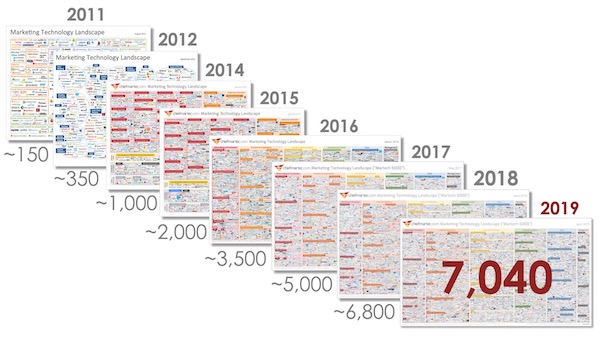by Andy Hugelier
Today’s enterprise marketers have an overwhelming number of choices when it comes to designing their technology stack. The ecosystem of marketing technology continues to grow, diversify and specialize, with dozens to hundreds of vendors to choose from in each category.
While there has been considerable consolidation at the top of the market, there still remains thousands of specialized niche players, disruptors and innovators that continue to launch new products and grow the landscape.

Scott Brinker’s “Martech 5000” recently surpassed 7,000 platforms in 2019, underlining the continued growth in this space.
With thousands of overlapping platforms and less-than-clearly-defined categories, the decision about where or how to invest in your tech stack can be downright daunting and chaotic.
The Challenges of the Enterprise Martech Stack

An example marketing tech stack from Microsoft
Our customers are some of the biggest brands in the world, and we love having conversations with them about their tech stack challenges. There are several common themes we hear, and usually these are around how marketers actually do their work across a marketing tech stack – often reflected in questions like the following:
- How can we manage analytics from multiple sources?
- How should we make requests of our creative team?
- What’s the best process to deliver assets to channel teams?
- How can we manage our assets throughout our marketing process?
It’s easy to get bogged down in platform-specific answers to these questions, which ultimately lead you down a road tied to specific platforms in your tech stack. This means your stack is designed around specific platform capabilities or features, making it very difficult to adjust or swap out with different tools. You end up building your stack for a specific platform, not for your marketing workflow.
Building for Functions, Teams, and Workflows
At Opal, we think about tech stacks and integrations through the lens of functions, teams, and workflows first. The different platforms, APIs, and their specific capabilities matter, of course, but they come second to the people, their roles, and their processes.
Marketing software is built to solve problems for humans, after all, yet many platforms lose sight of this truth. Opal’s mission is to revolutionize the way marketing teams work, and it’s through this lens we look at the tech stack.
When we work with our customers to map out their end-to-end marketing process, we focus on the different marketing functions (e.g., marketing strategy or asset management), the teams executing them, and the workflow between them.
So why do we take this philosophy?
Achieving Tech Stack Freedom
Understanding and aligning your tech stack to your organization’s functional workflow first allows customers to swap different platforms in and out of the stack, while keeping workflows intact.

This provides the freedom to keep your workflow consistent, no matter which tools or platforms are in your stack.
Despite being different platforms, with different APIs and capabilities, an integration between Opal and Adobe Experience Manager’s DAM, or Opal and Box are fundamentally the same. Marketing teams will still progress along the workflow the same way, no matter which platform works best for them.
Contrast this with building your tech stack to work with specific features of distinct platforms. If your organization decides to go in a different direction with certain marketing tools, your teams would have to re-evaluate the entire workflow.
With IT and operations teams constantly refining the marketing tech stack, this becomes a difficult, time-consuming, and costly exercise.
Reducing Friction with Integrations
Another benefit of Opal’s philosophy is that it identifies where our customers can gain additional efficiencies through integrations. By mapping out their entire marketing process across functions, we can identify friction points within the workflow.
These friction points cost significant time, money, and energy, and slow down the rate at which content can be activated in-market.
Since Opal isn’t tied to any specific platform through this lens, we can build integrations for our customers that truly solve inefficiencies in their workflow, instead of optimizing for specific platform’s APIs. This enables us to work with many different platforms in the martech ecosystem agnostically – plugging in and out of the tech stack and workflow.
A Philosophy for Tech Stack Freedom
As the martech ecosystem continues to trend towards increased fragmentation, allowing the platforms to drive the process of building your tech stack will not result in the most efficient end-to-end workflow.
Instead, an efficient practice frames a philosophy around understanding the people, processes, teams and workflows versus just the features and functions. It’s through this practice that you can build and modify the tech stack that’s right for you and your team.
And that is truly tech stack freedom.

